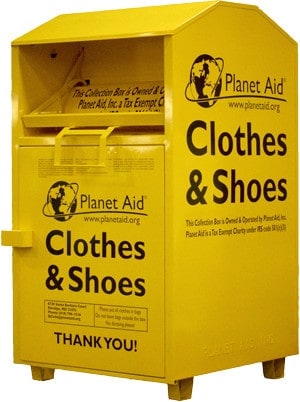Unveiling Clothing Bins Near You: A Family-Friendly Guide to Decluttering and Giving Back
Hey there, awesome parents! Are you on a mission to declutter your home and teach your little ones the joy of giving? You’re in the perfect place! Our comprehensive guide is here to help you find clothing donation bins in a snap, making it a rewarding experience for your whole family.
We understand that as a busy parent, you’re always on the lookout for ways to simplify life while instilling compassionate values in your children. Donating clothes to those in need checks both boxes—it’s a meaningful act of kindness and a fantastic way to clear out those overstuffed drawers and closets!
In this guide, we’ll take you step by step through the process of locating the nearest clothing bins, understanding what donations are accepted, and even exploring fun ways to get the kiddos involved in this benevolent activity. So, let’s get started on making a difference together!
Finding Clothing Bins Near You
Know what’s cooler than a treasure hunt? The hunt for nearby clothing donation bins—because the real treasure is the feeling you get from helping others! Here’s a little roadmap to finding that ‘X’ marks the spot:
Use Donation Bin Locator Tools Online
There’s a handy tool for just about everything these days, and locating clothing bins is no exception. Try out these smart resources:
- Google Maps: The go-to for finding just about anything. Simply type “clothing donation bins near me” in the search bar, and presto! A list of nearby options will appear.
- Charity websites: Non-profit organizations often have a ‘locator’ on their site. Plug in your ZIP code, and find a bin that’s just a hop, skip, and a jump away.
- Donation bin apps: Download an app dedicated to finding donation spots. With these, you can filter by type and distance, and sometimes even schedule a drop-off.
What Can You Donate?
Before you rush off to the clothing bins with bags in hand, it’s important to know what you can donate. Most bins happily accept:
- Gently used clothing of all types and sizes
- Shoes and accessories
- Linens and textiles
Always make sure the items are clean and in decent condition—think ‘would someone else be able to use this?’ Your worn-out ‘paint the house’ shirt might not make the cut, but those jeans your kiddo outgrew in a month? Perfect!
Remember, donating is not only about offering unused items but it’s also about providing quality. It’s part of the life lesson we’re teaching: giving our best to others.
Involve Your Children in the Process
Want to make donating clothes a family affair? Here are some tip-top ideas to involve your youngsters:
- Make it a game: Who can find the most items to donate? Turn decluttering into a fun challenge.
- Storytime significance: Discuss the importance of helping others and how donating clothes can have a positive impact.
- Designate a donation bin at home: Set up a special box where family members can place items they wish to give away. Once it’s full, plan a trip to a local donation bin together.
By engaging your kids in the process, they’ll learn valuable lessons in generosity, gratitude, and responsibility—skills that will dress them well for life.

Parents, let’s convert those barely-worn baby rompers and rapidly outgrown rain boots into acts of kindness. With each piece of clothing you drop into a donation bin, you’re not just clearing space in your home; you’re filling space in your heart and teaching your kids life’s greatest lessons.

5 Things Parents Should Know in Preparing for ‘Clothing Bins Near Me’
Getting ready to donate can be an adventure in itself! Being prepared is key to making this a smooth and impactful journey. Here are five essential things for you to keep in mind:
1. Seasonal Donations – Timing is Everything
While donations are welcome throughout the year, your seasonal clear-outs can be particularly helpful. Pack away and donate winter clothing as spring begins, or do the opposite as fall approaches. This ensures that charities can provide appropriate clothes to those in need at the right time.
2. Research the Most Needed Items
All donations are wonderful, but some items are in higher demand than others. For example, many charities seek children’s clothes, professional outfits for job interviews, and warm outerwear. A quick online check or a phone call can guide you to donate items that will make the biggest difference.
3. Involve the Kids in Quality Control
Teach your children about the importance of donating items in good condition. Let them help decide what is suitable for donation and what should be recycled or repurposed at home. This can be a great learning opportunity regarding sustainability and quality.
4. Understand Donation Policies
Different organizations have different policies. Some might not accept certain items, while others might have specific requirements for how clothes should be donated (e.g., bagged, tagged, etc.). Quick research will save time and ensure your donations are accepted.
5. Plan a Regular Donation Schedule
Make clothing donations a regular family habit rather than a one-off. Setting up a quarterly or bi-annual schedule can help manage the inflow and outflow of clothes in your home, keep clutter in check, and provide a steady supply of donations to your chosen charities.
Make it Educational and Fun
Emphasize the impact of decluttering not just on your home, but also on the community. Encourage your children to learn about the journey of their donated items. Many charities will explain how donations help, and some even provide tours or volunteer opportunities for older children.
Lastly, celebrate the act of donation as a family achievement. Whether it’s enjoying a special treat after dropping off the donations or reflecting on the good done, ensure the experience is positive and memorable.
Practical Preparation for Donation Day
When the donation day arrives, here’s a simple checklist to ensure everything goes off without a hitch:
- Confirm the location and operating hours of the charity bin or drop-off center.
- Double-check the items against the charity’s accepted donations list.
- Ensure all clothes are washed, dried, and free from tears or excessive wear.
- Prep your kids by talking about where the clothes are going and who they will help.
- Pack items in sturdy bags or boxes that are easy to transport.
By following these steps, not only will you have a smooth donation experience, but you’ll also be instilling a lifelong appreciation for philanthropy in your children – one garment at a time.
A Lasting Impact
Dear parents, consider the lasting impact of involving your family in the regular habit of donating clothes. These moments are not just about decluttering, but about teaching compassion, social responsibility, and the joy of sharing. And who knows, the outfits you donate may just brighten someone’s day or even change their life.
Thank you for embarking on this journey with your little ones, for sharing the warmth of your family with the world, and for transforming a simple act of clearing the closet into a circle of giving and receiving. Together, we can weave a tapestry of generosity across our communities, one clothing bin at a time.
For more great articles please see here. For more information see here
Disclaimer
The articles available via our website provide general information only and we strongly urge readers to exercise caution and conduct their own thorough research and fact-checking. The information presented should not be taken as absolute truth, and, to the maximum extent permitted by law, we will not be held liable for any inaccuracies or errors in the content. It is essential for individuals to independently verify and validate the information before making any decisions or taking any actions based on the articles.




